Cucumbers are usually easy to grow.
But if you find your cucumber leaves turning brown it’s a clear sign that your plant has a problem that may affect further growth and fruit yield.
So in this article, I’ll show you the most common causes, how to identify the problem, and what you can do about it.
Let’s dive in.
Cucumber Leaves Turning Brown: The Causes
There are 6 main causes of brown cucumber leaves: problems with water, nutrient deficiencies, temperature, insects, bacteria, and fungi.
Let’s take a closer look at each of these problems and how you can treat and prevent them.
Insect Pests
Insect infestations are a common cause of cucumber plant growth difficulties. They chew holes in leaves, making them susceptible to disease, and can even transmit harmful bacteria.
These are some of the most common types that result in leaves turning brown:
Four-lined Plant Bug (Poecilocapus lineatus)
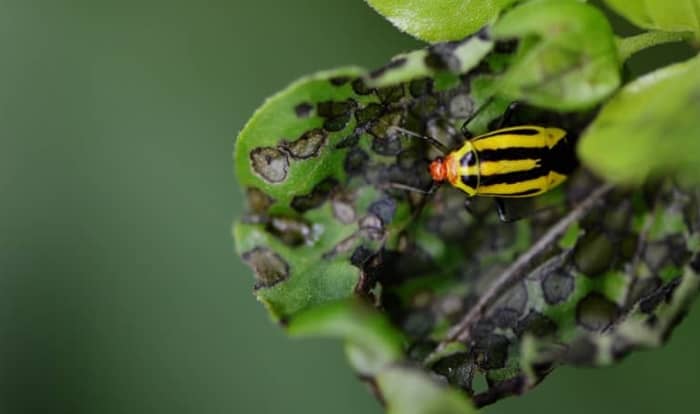
Photo by Katie Steiger-Meister
From May to early July in the Eastern two-thirds of the US and Southern Canada you’ll find the four-lined plant bug active.
They feed on leaves, leaving black and brown sunken spots where they’ve been.
You can identify them easily. The small red and black nymphs are visible in early Spring. And the adults grow to about ¼ of an inch in length and have black stripes down their yellow-green wings.
The feeding period is brief, and the damage they cause to the plant is rarely serious. So control measures are not usually necessary.
Just prune off the affected leaves in July after the bugs have gone to encourage new plant growth.
Squash Bug (Anasa tristis)
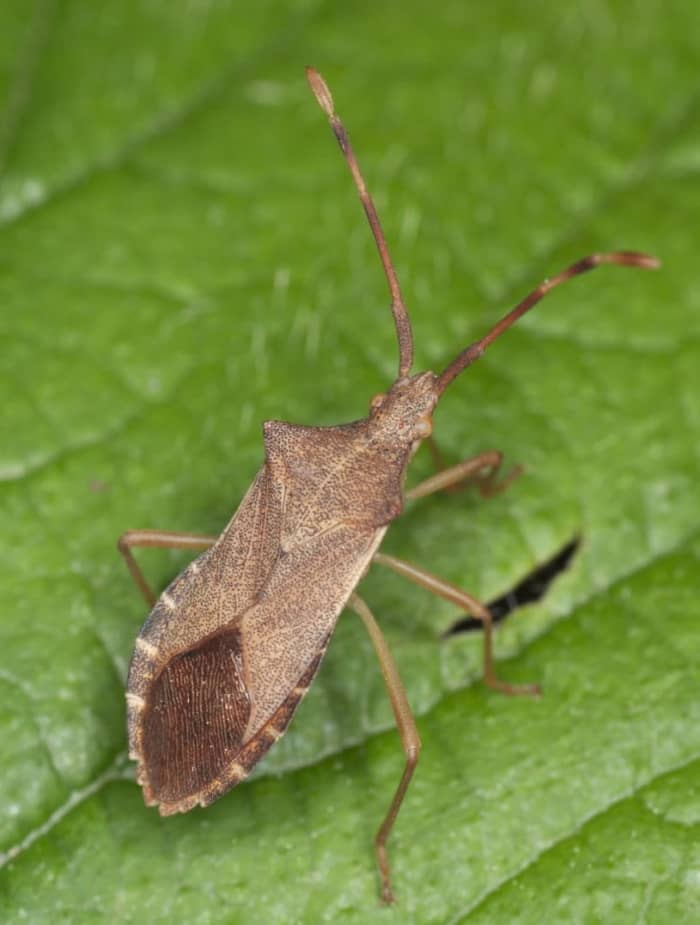
The squash bug has a nasty habit of sucking the sap out of your cucumber leaves. You’ll first notice the signs of their feeding as yellow spots that turn brown as the plant starts to wilt.
It’s more common to find them on pumpkins and squash. But if you’re growing cucumbers nearby then it’s not unusual for their feeding to spread.
They do the most damage on younger cucumber plants and seedlings, with more mature plants better able to withstand them.
You’ll find them from May until September, and identification is easy.
The gray-colored nymphs grow up to ½ an inch. And the 5/8 inch long adults have brown stripes on the edge of their gray/dark brown abdomen.
Large infestations are difficult to kill, so it’s important to detect them early. Hand-picking the bugs from the plant can help. And treating the plants with horticultural soaps or neem oil can also be effective.
Remember to clear up garden debris that can attract them, and remove infected leaves.
Aphids (Aphidoidea)
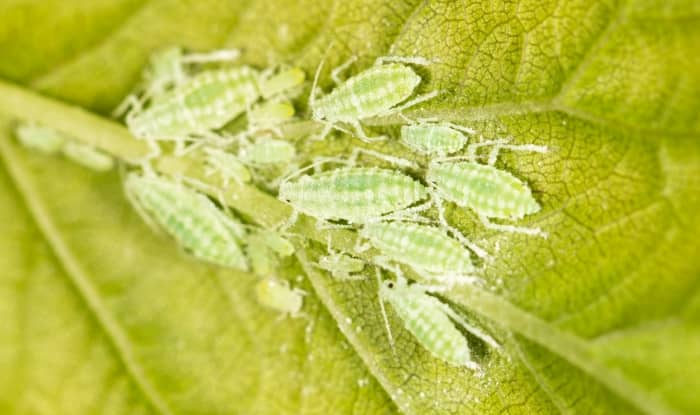
You’ll find aphids on the underside of cucumber leaves where they feed by sucking out the sap. This causes the leaves to distort in shape and start to lose color. If nothing is done to stop it, then the cucumber leaves turn yellow. And eventually, they turn brown and die.
As well as harming the plants directly, they also encourage the growth of sooty mold fungus. And they can infect your plants with cucumber mosaic virus.
You can spot spray with a natural insecticide such as neem oil to treat plants that have become infested.
Cucumber Beetles (Acalymma vittatum, Diabrotica undecimpunctata howardi)
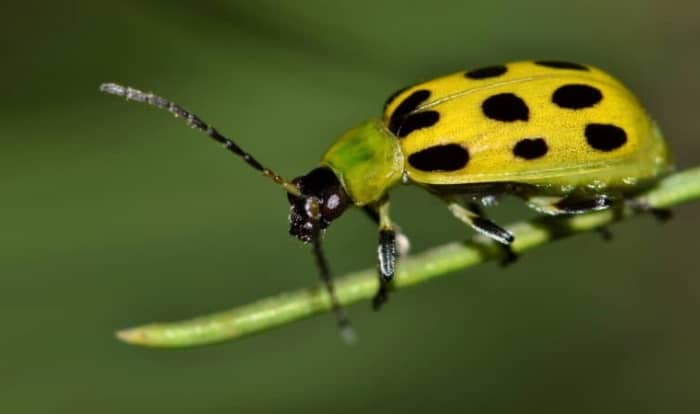
Adult cucumber beetles are yellow and about a ¼ of an inch long.
They come in 2 distinctive types: striped (Acalymma vittatum) and spotted (Diabrotica undecimpunctata howardi), distinguishable by their black markings.
They chew on the underside of leaves and eat away at the interior, while leaving the upper side intact. Eventually, this causes the leaves to turn brown and die.
They can also transmit bacterial wilt, which causes midseason wilting.
Controlling them is important to prevent the early death of your cucumber plants.
You can use row covers to protect them until the plants start to bloom. And treatment with insecticides such as Sevin (carbaryl), Entrust (spinosad), and natural pyrethrins can be effective.
Spider Mites (Tetranychus urticae)
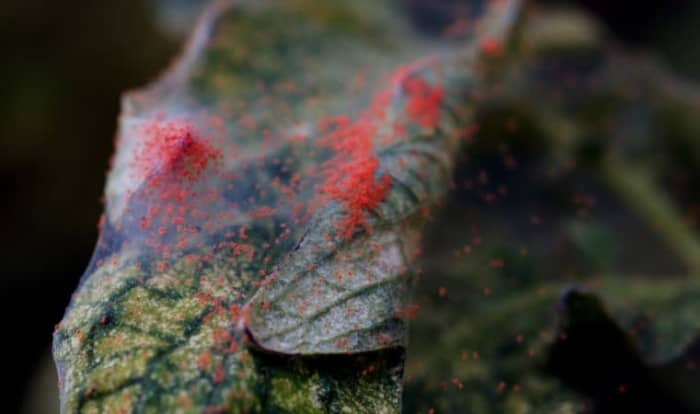
The red spider mite (Tetranychus urticae) is a common pest that does serious damage if left unchecked.
Due to their small size, they can be difficult to detect until present in large numbers.
The damage from their feeding appears as pale yellow and reddish-brown spots.
You can use insecticidal soaps to get rid of the infestation. And even a strong stream of water can clear them off the plants.
Fungal Infections
Fungal infections are another common problem for gardeners to deal with. They thrive in a range of conditions and easily spread between plants.
Quick identification and action are often needed to save the plant and the fruit.
Here are the most common types that cause browning of cucumber leaves:
Alternaria Leaf Blight (Alternaria cucumerina)
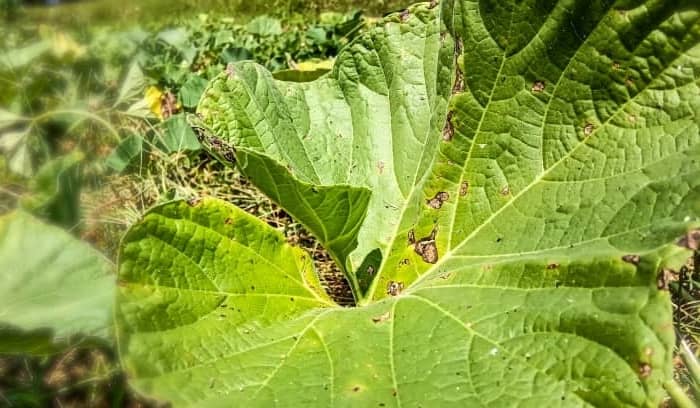
Leaf blight on a cucumber leaf
This fungus is found more frequently on melons, but it also occasionally grows on cucumber plants
It causes brown spots to appear on mature leaves. To begin with, they’re small, but they grow into large irregular shapes with a yellow edge.
The leaves will eventually wilt, turn brown, and then die. In the process, falling off and removing protection for the fruit, which can be damaged by the intense direct sunlight.
If you catch it early and only a few leaves are affected it’s a good idea to remove them to stop any further spread.
Otherwise, you’ll need to use a fungicide to treat this disease. But be aware that many commercial chemical fungicides will make your fruit inedible.
Organic gardeners prefer to use copper fungicides instead. But you can also try using a homemade fungicide with vinegar, soapy water, and baking soda.
For severe infections, it’s sometimes best to get rid of the plant entirely and replace the soil.
Anthracnose (Colletotrichum orbiculare)
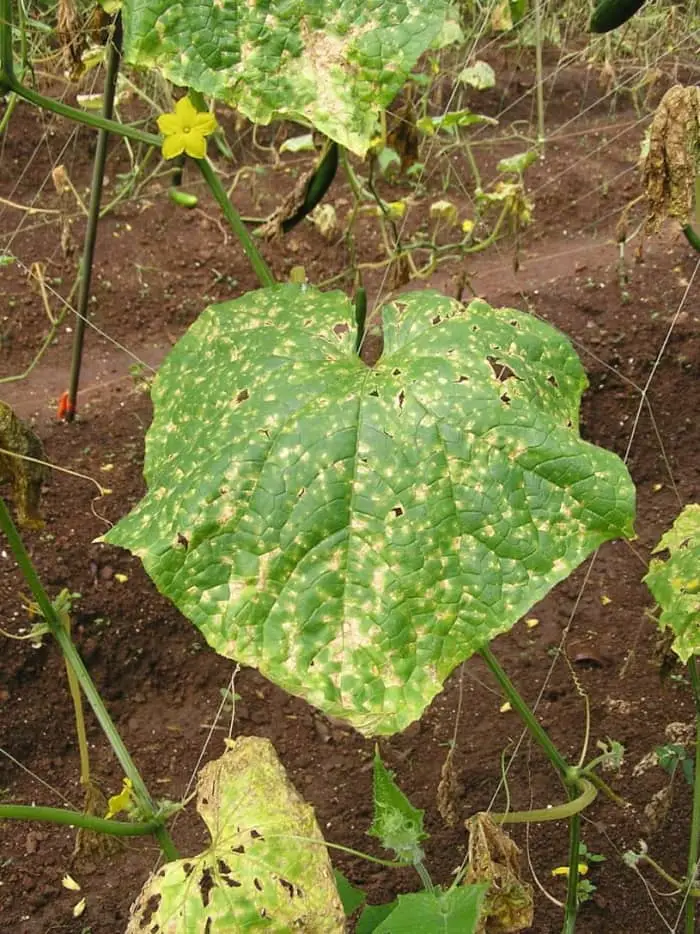
Anthracnose infected cucumber leaf
Anthracnose appears as yellow circles with dark brown edges that sometimes appear black. While these start off small, they become enlarged with disease progression.
It also affects the fruits, which sometimes develop a salmon-colored substance in the center of black sunken spots. These are fungal spores, and they provide an easy way to diagnose the disease.
Fungicides such as Benlate or Bravo can be used to treat the plant. But it will make the fruit inedible.
If the plant is heavily affected it can be a better choice to remove it and treat the soil before planting again.
Downy Mildew (Pseudoperonospora cubensis)
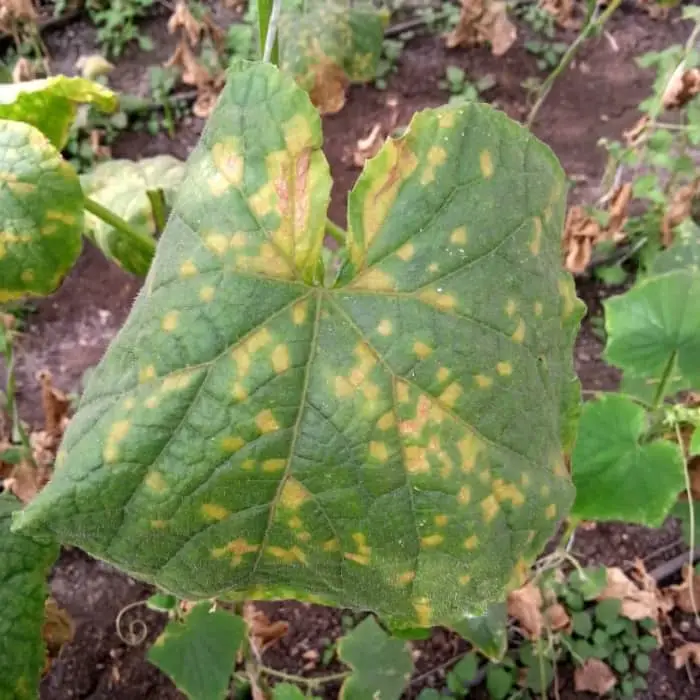
Downy mildew infected cucumber leaf
There are a number of different fungal species that cause downy mildew, with Pseudoperonospora cubensis being the causal agent on cucurbits. It often occurs where there are moisture and shade.
The first symptoms of infection are angular spots on the leaves ranging from yellow to light green. But as the disease gets worse the leaves will turn brown, dry out, and eventually, fall from the plant.
Check the underside of the leaves—you’ll usually find easily identifiable spores that appear as dark gray spots with a slight purple hue.
Treatment involves removing infected areas of the plant to stop the spread, and using fungicides such as Zampro, Curzate, Ranman, and Orondis.
Powdery Mildew (Podosphaera xanthii)
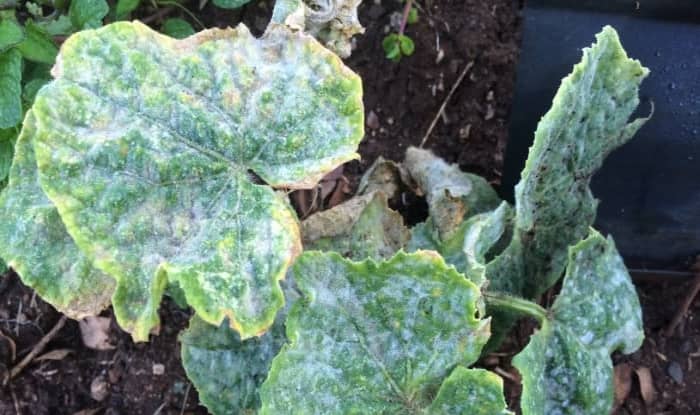
Powdery mildew on a cucumber leaf
Powdery mildew is one of the most common fungal diseases.
It’s easy to identify. Look for gray or white powdery spots that often cover most of the leaf surface. You’ll also see it on the stems and fruit.
In severe cases, you see curling of the leaves which eventually turn brown and die.
Other visible symptoms on the plant include malformed and under-sized fruit that’s sometimes discolored or has a speckled rind and shriveled handles.
Fortunately, the plant can usually recover from this disease.
Fungicides that contain the ingredient chlorothalonil are often effective.
For prevention, it’s a good idea to make sure that your vegetable plants get good air circulation by not crowding them.
And as the fungus tends to prefer low light, moderate temperatures, and high humidity it’s a good idea to situate your plants in an area where they can get at least 6 hours of sunlight each day.
Fusarium Wilt (Fusarium oxysporum)
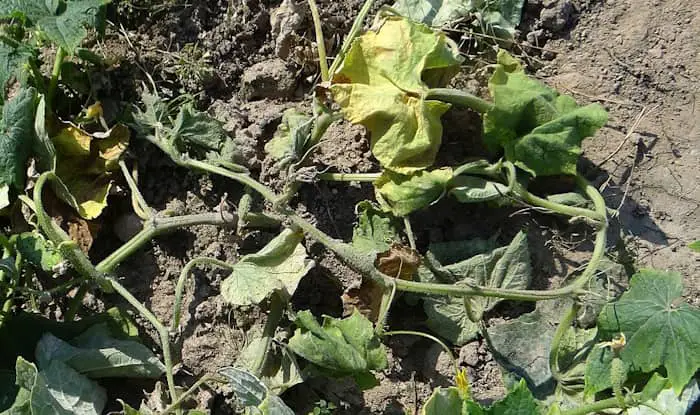
Fusarium wilt on cucumber plant leaves, Jerzy Opioła, CC BY-SA 4.0, via Wikimedia Commons
Although more commonly seen on potato and tomato plants, fusarium wilt can sometimes infect cucumber plants.
Unusually for a fungal disease, it spreads best in dry, hot conditions. With insects, tools, and contaminated water helping it move from plant to plant.
Cucumber leaves quickly change color to yellow or brown and appear dehydrated, with mature leaves usually affected before younger ones.
If you’re watering your cucumber plants regularly and can rule out dehydration, then these symptoms indicate a fusarium wilt infection.
To treat it, try removing the infected parts of the cucumber plant. Then spray fungicides such as Mycostop close to the root zone, making sure that it reaches the roots.
Verticillium Wilt (Verticillium dahliae)
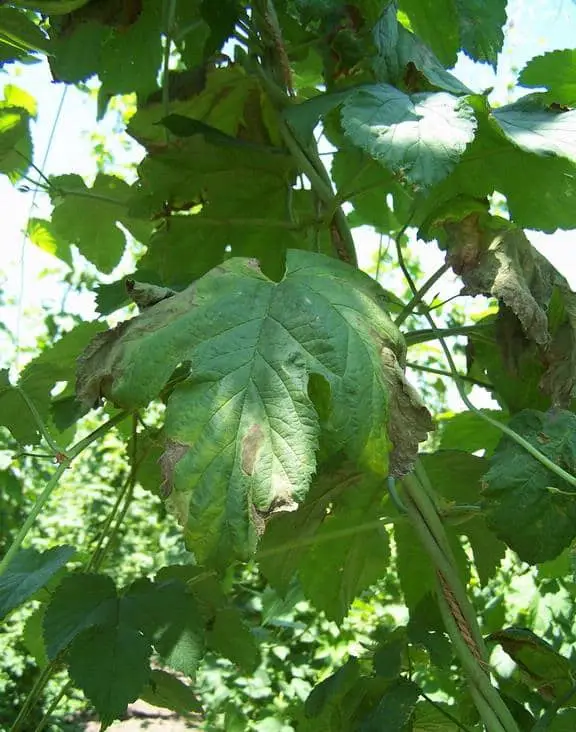
Verticillium wilt on hop leaves David Gent, CC BY-SA 4.0, via Wikimedia Commons
Verticillium wilt thrives in warm, moist conditions and infects plants through their roots. Similar to fusarium wilt, it’s spread through insects, water, and garden equipment.
The infection starts at the base of the stem and then works its way up. When it reaches the leaves it’s visible as irregularly shaped yellow spots. Sometimes, they turn brown and appear similar to Alternaria leaf blight, but without the distinctive halo.
Unfortunately, there aren’t any good treatments. To prevent the fungus from spreading you should remove affected parts of your cucumber plant, and you may have to get rid of the whole plant.
Make sure to sanitize the soil before replanting in the area as well as any garden tools you’ve been using.
Phytophthora Blight (Phytophthora capsici)
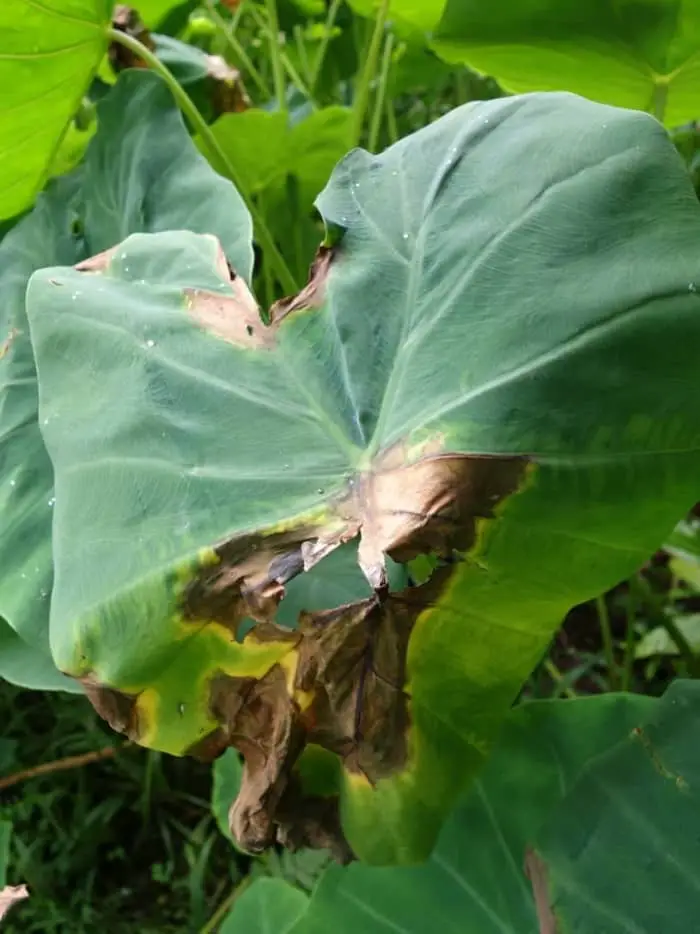
Phytophthora leaf blight of taro
This pathogen is more common in pumpkin and squash, but it can affect all cucurbits.
The infection affects all parts of the plant and eventually leads to total collapse.
But you can often identify it earlier by the large brown irregular shaped spots on the leaves, which also wilt.
The plants become easy to pull up from the ground as they lose their roots. And the fruit becomes covered with a white fungal growth and are soft and easy to puncture.
Infection is often spread through water and is most common in poorly drained areas of gardens or fields.
You should remove infected plants and fruit from your garden. Fungicide sprays will also help with prevention but they won’t prevent infected cucumbers dying.
If you have poor drainage, consider using raised beds.
Bacterial Infections
Bacteria are a common cause of leaf discoloration. Here are some of the most common bacterial infections that turn cucumber leaves brown:
Angular Leaf Spot (Pseudomonas syringae)
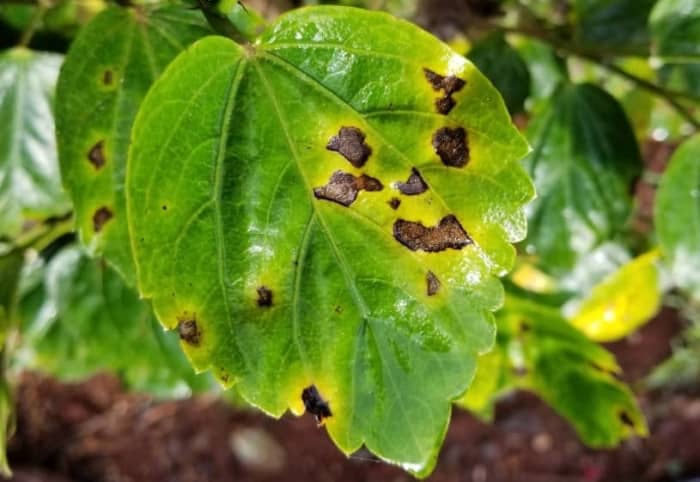
Angular leaf spot on hibiscus
The bacteria responsible for angular leaf spot gain access to leaves through areas bitten by insects.
First, you’ll notice small angular spots on the leaves that are dark brown or straw-colored and often with a yellow halo. These spots rapidly turn black, become very dry and crispy, and eventually fall out of the leaf leaving big holes behind.
Eventually, the dying leaves may fall off the plant exposing the cucumbers to the sun.
There’s no effective treatment, so your efforts should be spent on trying to prevent it.
From early spring, look out for harmful insects such as cucumber beetles. Remove them from your plants if you find them.
Row covers can also help stop insects from infesting your cucumber plants.
You can also use insecticides to keep the insect population under control.
Gummy Stem Blight and Black Rot (Didymella bryoniae)

Leaf affected by Didymella bryoniae
A common disease that affects the entire plant and thrives during wet and warm weather.
Look for brown leaf spots, as well as brown on the leaf edges, tips, and between veins. Sometimes you’ll see a yellow halo surrounding the spots, which become dry and brittle as they age.
The stems show black spots or brown lesions that are fringed with black, which also may ooze gummy fluids.
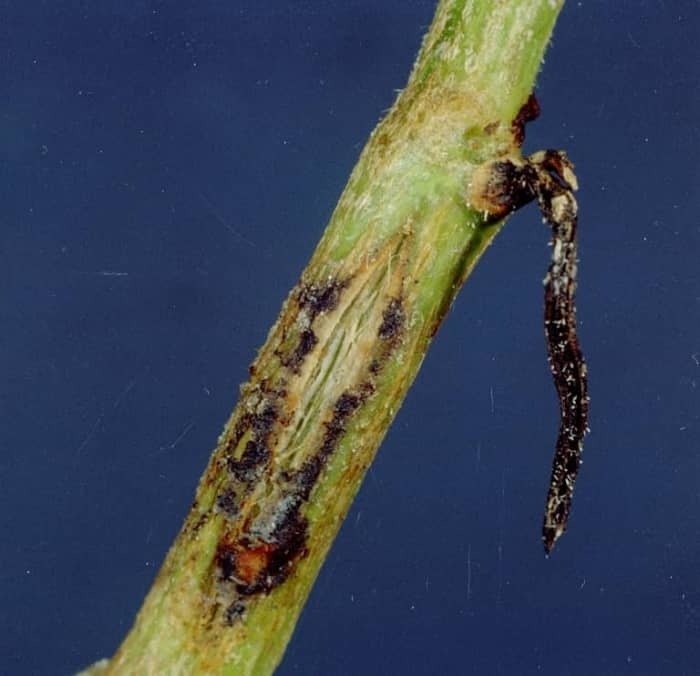
Gummy stem blight lesion Clemson University – USDA, CC BY 3.0 US, via Wikimedia Commons
The infection of the fruit usually starts on the side that touches the soil and leads to black rot.
Treatment can be done using one of the following fungicides: mancozeb, chlorothalonil, or copper oxychloride.
If you suspect that your plants are suffering from this infection it’s a good idea not to plant susceptible cucurbits in that area the following year.
Bacterial Wilt (Erwinia tracheiphila)
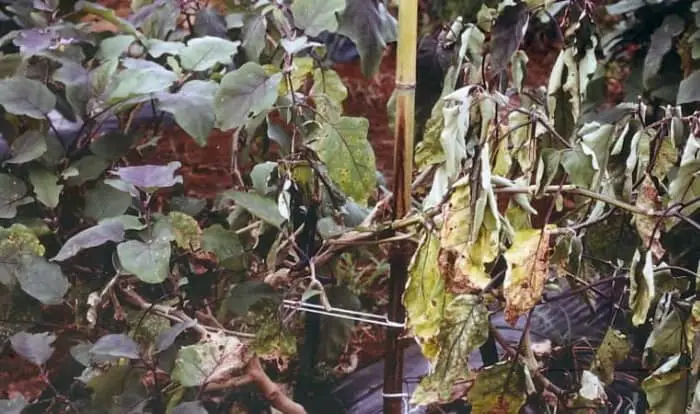
Bacterial wilt of eggplant
As mentioned above, bacterial wilt is often spread by cucumber beetles. Transferring the bacteria from infected plants to uninfected ones while they feed.
To begin with, yellow leaves that wilt and appear dry become visible. But, it quickly spreads around the plant and the cucumber leaves turn brown.
If you suspect bacterial wilt, look for the beetles for confirmation. Another test you can use is to cut an infected leaf at the stem. When put in a glass of water milky sap should become visible which confirms the bacterial wilt infection.
There’s no good treatment for infected plants, so there’s no way to prevent them from dying. Stopping bacterial wilt means preventing the beetles that carry it.
Water
Cucumber plants can suffer from either a lack of moisture or too much of it.
Because they require a lot of water for healthy growth, you need to make sure the soil is well watered.
If they don’t get enough, then you’ll notice the leaves wilting in the sunlight. Followed by the browning of the foliage as it starts to die.
Make sure you water your cucumbers at least 1-2 times per week. If you can feel that the top inch of the soil is dry then it’s time to give them a drink.
It’s important to be consistent with this. Because even if lack of water doesn’t kill your plants it can lead to bitter-tasting fruit.
If your plants are growing in your garden, then make sure the root zone is well saturated. The main bulk of the roots are in the top 8 inches of the soil.
If you’re growing in a container, then make sure it has good drainage holes and water until you see it running out of the bottom.
Less frequent but deep watering is preferred to daily watering. The roots of the plant don’t like sitting in damp and oxygen-depleted soil and will eventually develop a fungus that will kill the plant.
Temperature
Has the temperature dropped lately?
Cucumbers don’t like the cold. Sustained temperatures below 50°F can cause discolored and wilted leaves. Look for the edges turning from olive green to brown.
Even overnight drops in temperature below 60°F will cause your plants to suffer.
Nutrient Deficiency
If the browning is due to nutrient deficiencies in the soil, you can address this by fertilizing your cucumber plants appropriately.
Conduct a soil test to determine any nutrient deficiencies and then apply a balanced fertilizer or an appropriate nutrient amendment based on the test results. Follow the instructions on the fertilizer package for application rates and frequency.
FAQ
Should I Cut Off Brown Cucumber Leaves?
If you notice brown leaves on your cucumber plant, it’s essential to determine the cause before deciding whether to cut them off. Brown leaves can indicate various issues, including disease, pest infestation, nutrient deficiencies, or environmental stress. If there is just a small amount of browning at the edges, fixing the problem may cause the leaves to to recover.
If you’ve determined that your cucumber leaves are turning brown due to normal aging, or factors that make their recovery unlikely, you can choose to prune them. Removing severely damaged or diseased leaves can prevent the problem from spreading further and improve the plant’s appearance.
How Should I Treat Brown Cucumber Leaves?
Treating brown cucumber leaves involves addressing the underlying cause of the browning. It’s essential to properly diagnose the cause of the browning before implementing the appropriate treatment.
If you’re uncertain about the underlying problem or need specific advice for your region, consult a local gardening expert or agricultural professional for guidance tailored to your situation
Do Cucumber Leaves Become Brown As They Age?
Yes, it is normal for cucumber leaves to turn brown and dry up as they age. Cucumber plants naturally shed their older leaves as new growth occurs. As the plant continues producing leaves, the older leaves closer to the plant base will gradually turn yellow and brown.
This natural process is not a cause for concern as long as the rest of the plant appears healthy and vibrant. Regularly removing these brown, dry leaves can help maintain the plant’s appearance and improve airflow around the plant, reducing the risk of disease.
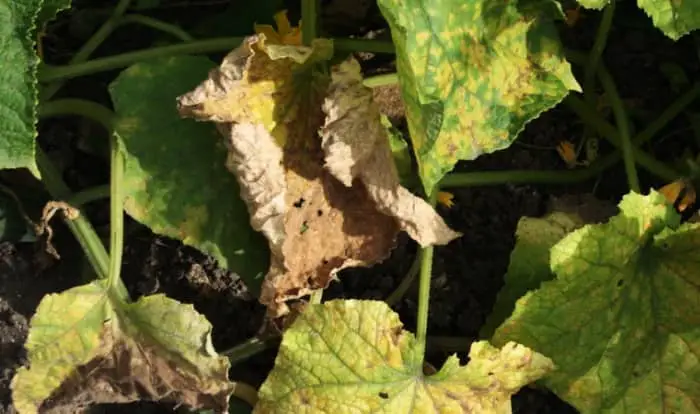
Thanks! that was very helpful!